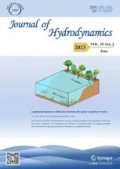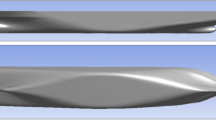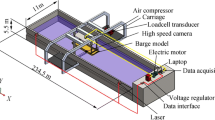Abstract
A novel air bubble lubrication method using the winged air induction pipe (WAIP) device is used to reduce the frictional drag of the hull of the ship and hence increase the efficiency of the propulsion system. This bubble lubrication technique utilizes the negative pressure region above the upper surface of the hydrofoil as the ship moves forward to drive air to the skin of the hull. In the present study, the reduction rate of the drag by applying the WAIP device is numerically investigated with the open source toolbox OpenFOAM. The generated air layer and the bubbles are observed. The numerical results indicate that the reduction rate of the drag closely depends on the depth of the submergence of the hydrofoil, the angle of attack of the hydrofoil, and the pressure in the air inlet. It is also proportional to the air flow rate. The underlying physics of the fluid dynamics is explored.
Similar content being viewed by others
References
Molland A. F., Turnock S. R., Hudson D. A. ‘Components of hull resistance’, in ship resistance and propulsion: Practical estimation of propulsive power [M]. Cambridge: Cambridge University Press, 2011, 12–68.
Mäkiharju S. A., Perlin M., Ceccio S. L. On the energy economics of air lubrication drag reduction [J]. International Journal of Naval Architecture and Ocean Engineering. 2012, 4(4): 412–422.
Butterworth J., Atlar M., Shi W. Experimental analysis of an air cavity concept applied on a ship hull to improve the hull resistance [J]. Ocean Engineering, 2015, 110: 2–10.
Saxe, H., Larsen T. Air pollution from ships in three Danish ports [J]. Atmospheric Environment, 2004, 38(24): 4057–4067.
Elbing B. R., Winkel E. S., Lay K. A. et al. Bubble-induced skin-friction drag reduction and the abrupt transition to air-layer drag reduction [J]. Journal of Fluid Mechanics, 2008, 612: 201–236.
Ceccio S. L.. Friction drag reduction of external flows with bubble and gas injection [J]. Annual Review of Fluid Mechanics, 2010, 42: 183–203.
Kato, H., & Kodama, Y. Microbubbles as a skin friction reduction device—A midterm review of the research [C]. In 4th Symposium on Smart Control of Turbulence, Tokyo, Japan,2001.
Foeth E. J. Decreasing frictional resistance by air lubrication [C]. 20th International Hiswa Symposium On Yacht Design and Yacht Construction, Amsterdam, 2008.
Mccormick M. E., Bhattacharyya R. Drag reduction of a submersible hull by electrolysis [J]. Naval Engineers Journal, 1973, 85(2): 11–16.
Evseev A. R., Mal’tsev L. I. Effect of microbubble gas saturation on near-wallturbulence and drag reduction [J]. Journal of Engineering Thermophysics, 2018, 27(2): 155–172.
Kodama Y., Hinatsu M., Hori T. et al. A full-scale air lubrication experiment using a large cement carrier for energy saving (result and analysis) [C]. In Conference Proceedings, the Japan Society of Naval Architects and Ocean Engineers, 2008, 6: 163.
Jang J., Choi S. H., Ahn S. M. et al. Experimental investigation of frictional resistance reduction with air layer on the hull bottom of a ship [J]. International Journal of Naval Architecture and Ocean Engineering, 2014, 6(2): 363–379.
Mizokami S., Kawakita C., Higasa S. et al. Experimental study of air lubrication method and verification of effects on actual hull by means of sea trial [J]. Mitsubishi Heavy Industries Technical Review, 2010, 47(3): 41–47.
Murai Y., Kumagai I., Tasaka Y. et al. Hydrofoil type of bubble generator for marine drag reduction [J]. Transactions of the Japan Society of Mechanical Engineers, 2010, 763: 483–485.
Kumagai I., Nakamura N., Murai Y. et al. A new power-saving device for air bubble generation: hydrofoil air pump for ship drag reduction [C]. In Proceedings of the International Conference on Ship Drag Reduction SMOOTH-SHIPS, 2010.
Kumagai I., Takahashi Y., Murai Y. Power-saving device for air bubble generation using a hydrofoil to reduce ship drag: Theory, experiments, and application to ships [J]. Ocean Engineering, 2015, 95: 183–194.
Kodama Y., Kakugawa A., Takahashi T. et al. Experimental study on microbubbles and their applicability to ships for skin friction reduction [J]. International Journal of Heat and Fluid Flow, 2000, 21(5): 582–588.
Verschoof R. A., van der Veen R. C., Sun C. et al. Bubble drag reduction requires large bubbles [J]. Physical Review Letters, 2016, 117(10): 104502.
Zotti I., Miotto S. Study and numerical simulation of the drag reduction on a flat plate lubricated by air injection by micro bubbles [M]. Towards Green Marine Technology and Transport. Edited by Carlos GuedesSoares, RokoDejhalla, and DuskoPavletic CRC Press, 2015, 67–74.
Alfonsi G. Reynolds-averaged navier-stokes equations for turbulence modeling [J]. Applied Mechanics Reviews, 2009, 62(4): 040802.
Menter F. R., Kuntz M., Langtry R. Ten years of industrial experience with the SST turbulence model [J]. Turbulence, heat and mass transfer, 2003, 4(1).
Zhang J., Yang S., Liu J. Numerical investigation of a novel device for bubble generation to reduce ship drag [J]. International Journal of Naval Architecture and Ocean Engineering, 2018, 10(5): 629–643.
Khalil M. F., Kassab S. Z., Adam I. G. et al. Prediction of Lift and Drag Coefficients on Stationary Capsule in Pipeline [J]. CFD Letters, 2009, 1(1): 15–28.
Liu J., Yap Y. F., Nguyen N. T. Numerical study of the formation process of ferrofluid droplets [J]. Physics of Fluids, 2011, 23(7): 072008.
Duncan J. H. The breaking and non-breaking wave resistance of a two-dimensional hydrofoil [J]. Journal of Fluid Mechanics, 1983, 126: 507–520.
Karim M. M., Prasad B., Rahman N. Numerical simulation of free surface water wave for the flow around NACA 0015 hydrofoil using the volume of fluid (VOF) method [J]. Ocean Engineering, 2014, 78: 89–94.
Author information
Authors and Affiliations
Corresponding author
Additional information
Biography: Jun Zhang (1978-), Male, Ph. D.
Project supported by the National Natural Science Youth Foundation of China (Grant No. 11902125).
Rights and permissions
About this article
Cite this article
Zhang, J., Yang, S. & Liu, J. Numerical investigation of frictional drag reduction with an air layer concept on the hull of a ship. J Hydrodyn 32, 591–604 (2020). https://doi.org/10.1007/s42241-019-0063-8
Received:
Revised:
Accepted:
Published:
Issue Date:
DOI: https://doi.org/10.1007/s42241-019-0063-8




